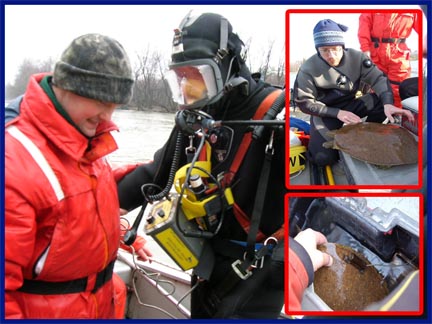
Turtles at Champlain Bridge
Finding a way to locate and track individuals and groups of marine animals has always been a challenge for scientists. When a new bridge was being built over part of Lake Champlain near the US-Canadian border, researchers with Quebec's Ministry of Natural Resources and the Vermont Fish and Wildlife Department wanted to know how it would affect the resident turtle population. To determine if the construction would have a negative impact on the reptiles, a study was conducted over a four year period. Twenty three turtles were captured and a transmitter attached to the shell of each one allowing them to be tracked and studied. At the conclusion of the project investigators wanted to remove the $1,000 tracking devices for possible re-use, and to mitigate any long term impact on the animals. Richard Savignac, a Canadian Diving Safety Officer working with the group reports, ‘We had decided from the start an underwater metal detector would be the best tool for the recovery effort as the transmitter had metallic elements. We began the search by using a radio telemetry antenna on the surface to locate the approximate position of the turtles on the bottom. Once a site had been identified, a diver was then deployed with a JW Fishers Pulse 8X detector. All twenty three of our test subjects were located alive and well, and the transmitters were successfully detached. We concluded our team had developed an effective methodology and innovative approach to replace or remove transmitters from specimens."
Another government agency employing metal detectors in their work with turtles is Hong Kong's Department of Agriculture, Fisheries, and Conservation. The green sea turtle is fighting for survival in the territory's waters, but the government is working hard to rebuild their numbers. This bustling capitol of commerce seems an unlikely place to find an endangered species, but the 200 islands that make up Hong Kong are a key hatchery for the green giant which can weigh up to 150 kg. KS Cheong, a wetlands and fauna conservation officer, says his department is responsible for conserving the sea turtle's habitat, which are the many beaches of the islands. He says, "In Hong Kong I would say the biggest problem is personal consumption of the eggs and turtles. We bury metal plates to mark the nest's locations so we can protect them, and guard against poachers. Often the plates get covered with sand and we use a Pulse 8X to relocate them. We used some other detectors before, but their performance was poor. A professor at Taiwan University used the JW Fishers detector for the same purpose and reported excellent results, so we acquired one for our department."
Other scientists using these detectors in their work are Dr. Hunter Lenihan, professor of applied marine ecology at University of California Santa Barbara, and Dr. Tasman Crowe with Australian Centre for International Agricultural Research. Dr. Lenihan studies the effects of restoration, ecotoxicology, and ocean resource management on marine communities. As part of this work Lenihan and his team are cultivating disease resistant abalone in an effort to increase their numbers. To gather the needed data they must examine the health of many individuals over an extended period of time. To aid in locating the shellfish, researchers affix a small metal tag to them which can be detected with their Pulse 8X. Dr. Crowe is involved in a stock enhancement project of trochus, a marine gastropod that inhabits shallow tropical reefs. The shell of mature adults is used to make buttons and jewelry. The global demand for trochus is over 7,000 tons annually, putting the fishery under stress. Crowe and his team are working on a reseeding project, but were having difficulty tracking and tagging animals that often move into and under coral or ruble. To solve the problem they affixed small metal tags to the trochus and use a Pulse 8X to find them. He reports, "the effectiveness of the system was proven with 85% of a known number of juveniles consistently recaptured."
A few of the many other agencies using Fishers equipment are the Alpena Fisheries Research Station with Michigan's Department of Natural Resources, NOAA Office for Coastal Management, Arkansas Game & Fish Commission, Wisconsin Cooperative Fisheries Institute part of Univ. of Wisconsin, Fisheries and Oceans Canada's Gulf Fisheries Center, New Hampshire Fish & Game Dept., Sea Fisheries Institute in Poland, Skidway Institute of Oceanography, and the South Pacific Applied Geoscience Community (SOPAC).
